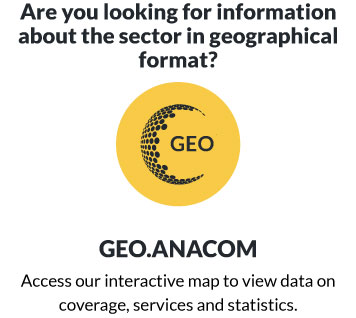Infraestruturas e Habitação (Infrastructures and Housing)
Administrative Rule
(This is not an official translation of the law)
Administrative Rule no. 270-A/2020 of 23 November (Full version in PDF)
Administrative Rule no. 1473-B/2008 of 17 December, amended and republished by Administrative Rule no. 296-A/2013 of 2 October, and subsequently amended by Administrative Rule no. 378-D/2013 of 31 December and Administrative Rule no. 157/2017 of 10 May, approved the amount of fees payable to the National Authority for Communications (ANACOM).
As regards fees payable for the use of frequencies, since they concern the public domain of the State, it is important that resources be soundly managed and efficiently used, ensuring that the fees reflect the inherent value of the radioelectric spectrum allocated in line with the public interest, in particular as regards protecting the interests of citizens, for which the security and integrity of electronic communications networks and services are critical factors.
Once again, in the field of mobile communications, progress is being made towards increasing the efficiency of spectrum use, in particular the ability to use various frequency bands simultaneously, due to technology developments and equipment. In addition, in the European Union, the groundwork has been laid to use more of the radioelectric spectrum to support electronic communications services, namely in the 700 MHz and 3.6 GHz bands, which have been identified as relevant for supporting 5G systems.
In this context, Regulation no. 987-A/2020 of 5 November governs the conditions for offering the market different quantities of spectrum in the 700 MHz, 900 MHz, 1800 MHz, 2.1 GHz, 2.6 GHz and 3.6 GHz bands by means of an auction for the allocation of frequency usage rights.
It is believed that the frequency bands that will initially provide the basis for offering 5G-compatible services, in view of the state of the art of technology, likely warrant an amount lower than fees for the use of other bands allocated to the provision of terrestrial electronic communication services.
Therefore, in compliance with Resolution of the Council of Ministers no. 7-A/2020 of 7 February, a new lower amount has been established for the annual fees to use this spectrum when acquired under the auction procedure, so as not to thwart expectations of guaranteeing the national interest, under a policy that prioritises mobile networks of extremely high capacity, to the detriment of financial proceeds, if necessary.
In addition, and in compliance with (4) of Resolution of the Council of Ministers no. 7-A/2020 of 7 February, fees due for the use of frequencies are also lower for spectrum holders who agree to ensure, whether individually or jointly, mobile broadband coverage with a 100 Mbps minimum debit for all State schools at all levels of education and the Northern railway line.
This administrative rule also considers that, on 29 May 2018, the “Forest Fires – Measures for the Protection and Resilience of Electronic Communications Infrastructure” workgroup created and coordinated by ANACOM publicly presented its final report including a collection of measures to enhance the protection and resilience of electronic communications infrastructure, especially in the event of forest fires.
Specifically, this workgroup concluded that the use of hertzian connections allows transmission and transport networks to be deployed with a lower risk of being affected by forest fires and other natural disasters.
Hertzian connections are thus an alternative to cable layouts, or serve as a solution for improving network redundancy, resulting in the conclusion that their use can be encouraged through appropriate fees for the use of frequencies.
In this context, the differentiation in fees should be based on weighted, understandable criteria that match and address the goals and purposes the measure in question aims to achieve, ensuring that its application corresponds to and includes the areas of the national territory that, for various reasons, actually can and should benefit specifically from resilience and redundancy improvements to electronic communications infrastructures through the use of hertzian connections.
The decision has thus been made to identify those parishes that, for reasons involving population density, demographics, number of people, physical characteristics of the territory, socio-economic characteristics and accessibility, could be particularly susceptible to fires or other natural disasters.
It is believed that this identification should be based on parishes classified as low-density territories under the Portugal 2020 program by decision, dated 1 July 2015, of the Interministerial Coordination Committee (CIC) concerning the “Classification of low-density territories for the application of positive territorial differentiation measures” and those identified as subject to the measures of the National Program for Territorial Cohesion (PNCT) in annex III of Resolution of the Council of Ministers no. 72/2016 of 24 November, associated with priority areas for overseeing the management of fuels, per Order no. 744/2019 of 17 January of the Secretaries of State for Civil Protection and for Forests and Rural Development, since their inclusion clearly makes them areas that should specifically benefit from measures to improve the resilience and redundancy of electronic communications infrastructures in the event of fires or other natural disasters.
The Autonomous Regions of the Azores and Madeira were not subject to the CIC's decision, the resolution or the order referred to above. Given that, for the purposes now envisaged, a differentiated amount is not only appropriate but even requisite. In view of the particular social, geographic, orographic and seismological characteristics of these outermost autonomous regions, it is believed that the parishes of the Autonomous Regions of the Azores and Madeira should also be included among the areas subject to the new fees established herein.
It is further believed that, in the event of interruptions to public communications or publicly accessible electronic communications services due to natural catastrophes, terrorist attacks or acts of sabotage, regardless of their origin or responsible agent, the national interest in re-establishing communications as quickly as possible justifies a lower fee for the use of hertzian beams for this purpose throughout the entire national territory.
Furthermore, in view of the importance of ensuring that these measures actually contribute towards obtaining the desired results, it is believed that ANACOM should be entrusted with periodically monitoring the deployment of the hertzian connections in question by companies offering electronic communications networks.
From another standpoint, considering the enhanced efficiency and effectiveness of the working processes involved in the exercise on the part of ANACOM, for its functions involving access (both with regard to the electronic communications sector and the postal services sector), with an ensuing administrative cost reduction in relation to these processes, the amount of the fees due for these acts can be decreased.
Finally, the amount due for the allocation of frequency usage rights is established, pursuant to ANACOM Regulation no. 987-A/2020 of 5 November,
which determines the procedures applicable to the auction for the allocation of frequency usage rights in the 700 MHz, 900 MHz, 1800 MHz, 2.1 GHz, 2.6 GHz and 3.6 GHz bands.
ANACOM has been heard, pursuant to article 37 (2) of its Statutes, approved by Decree Law no. 39/2015 of 16 March.
Therefore:
The Government hereby determines, through the Deputy Secretary of State for Communications, under the powers delegated by Order no. 11146/2020 of 12 November, pursuant to the combined provisions of article 105 (3) of Law no. 5/2004 of February, amended and republished by Law no. 51/2011 of 13 September, and subsequently amended by Law no. 10/2013 of 28 January and Law no. 42/2013 of 3 July, by Decree Law no. 35/2014 of 7 March, by Law no. 82-B/2014 of 31 December, Law no. 127/2015 of 3 September and Law no. 15/2016 of 17 June, and by Decree Law no. 92/2017 of 31 July, article 19 (7) of Decree Law no. 151-A/2000 of 20 July, amended and republished by Decree Law no. 264/2009 of 28 September, and subsequently amended by Law no. 20/2012 of 14 May and Law no. 82-B/2014 of 31 December, article 44 (3) of Law no. 17/2012 of 26 April, amended by Decree Law no. 160/2013 of 19 November and by Law no. 16/2014 of 4 April, and article 37 (2) of the Statutes of ANACOM, approved by Decree Law no. 39/2015 of 16 March, the following:
Article 1
Amends article 15 of Administrative Rule no. 1473-B/2008 of 17 December
The following paragraph is added to article 15 of Administrative Rule no. 1473-B/2008 of 17 December, amended and republished by Administrative Rule no. 296-A/2013 of 2 October, and subsequently amended by Administrative Rule no. 378-D/2013 of 31 December and Administrative Rule no. 157/2017 of 10 May:
“3 — The frequency usage rights in the 700 MHz and 3.6 GHz bands acquired under the auction procedure laid out in Regulation no. 987-A/2020 of 5 November shall be subject to a reduction of 80% of the fee for the use of frequencies assigned for terrestrial electronic communication services, over the initial duration of the respective frequency usage rights in these bands.”
Article 2
Amends annex I of Administrative Rule no. 1473-B/2008 of 17 December
Annex I (1) of Administrative Rule no. 1473-B/2008 of 17 December, amended and republished by Administrative Rule no. 296-A/2013 of 2 October, and subsequently amended by Administrative Rule no. 378-D/2013 of 31 December and Administrative Rule no. 157/2017 of 10 May, shall now read as follows:
“1 — The fee due for the issuance of statements of rights for confirmation, pursuant to article 21 (5) of Law no. 5/2004 of 10 February, to entities offering electronic communications services and networks accessible or not accessible to the public, shall be set at the following amount:
( See the full version in PDF format)
Article 3
Amends annex IV of Administrative Rule no. 1473-B/2008 of 17 December
1 — Annex IV (1.1) of Administrative Rule no. 1473-B/2008 of 17 December, amended and republished by Administrative Rule no. 296-A/2013 of 2 October, and subsequently amended by Administrative Rule no. 378-D/2013 of 31 December and Administrative Rule no. 157/2017 of 10 May, shall now read as follows:
“1.1 — […]
( See the full version in PDF format)
2 — Annex IV (1.4.1) of Administrative Rule no. 1473-B/2008 of 17 December, amended and republished by Administrative Rule no. 296-A/2013 of 2 October, and subsequently amended by Administrative Rule no. 378-D/2013 of 31 December and Administrative Rule no. 157/2017 of 10 May, shall now read as follows:
“1.4.1 — […]
Applicable fee per bidirectional hertzian connection and per assigned channel:
( See the full version in PDF format)
Where L is the distance of the hertzian connection in kilometres (rounded to three decimal points).
Point-multipoint connections are comprised of a set of point-point connections. In this particular case, the applicable fee will result from the sum of fees calculated for each of the point-point connections.
The applicable fee of a second, co-channel hertzian connection, on the same route and with cross-polarisation, is reduced by 50%.
Unidirectional Hertzian connections are subject to a reduction of 25% relative to the fee amount that applies to bidirectional connections.
The fee amount applicable to hertzian connections, when the location of at least one fixed station is within the territory of one of the parishes referred to in annex X of this administrative rule, shall be set at half of the amount applicable to the others.
The minimum applicable usage fee per connection and per assigned channel shall be set at €50.
A 100% reduction shall apply to the applicable fee for the use of hertzian beams in lieu of physical connections such as optical fibre, coaxial cable and copper pair, to re-establish public communications or electronic communications services accessible to the public in the event of natural disasters such as fires, acts of terrorism or sabotage, for a maximum of 180 days, subject to renewal for the same or for a lesser time period.
For the purposes of reducing the fee referred to in the above paragraph, applicants must provide ANACOM with justifying grounds for their eligibility.”
Article 4
Amends annex IX of Administrative Rule no. 1473-B/2008 of 17 December
Annex IX (1) of Administrative Rule no. 1473-B/2008 of 17 December, amended and republished by Administrative Rule no. 296-A/2013 of 2 October, and subsequently amended by Administrative Rule no. 378-D/2013 of 31 December and Administrative Rule no. 157/2017 of 10 May, shall now read as follows:
“1 — […]”
( See the full version in PDF format)
Article 5
Amendment to Administrative Rule no. 1473-B/2008 of 17 December
Annex X is added to Administrative Rule no. 1473-B/2008 of 17 December, amended and republished by Administrative Rule no. 296-A/2013 of 2 October, and subsequently amended by Administrative Rule no. 378-D/2013 of 31 December and Administrative Rule no. 157/2017 of 10 May, to read as follows:
“ANNEX X
List of parishes with reductions to the applicable fee per (1.4.1) of annex IV
( See the full version in PDF format)
Article 6
ANACOM oversight
1 — ANACOM shall be responsible for overseeing the implementation, by companies offering electronic communications networks, of the measures to improve the resilience, restoration and redundancy of electronic communications infrastructures through the use of hertzian connections in the parishes shown in annex X of Administrative Rule no. 1473-B/2008 of 17 December, as worded in this administrative rule.
2 — Every two years, ANACOM must provide the Government with a report on its oversight of the implementation, by companies offering electronic communications networks, of measures to improve the resiliency and redundancy of electronic communications networks through the use of hertzian connections in the parishes shown in annex X of Administrative Rule no. 1473-B/2008 of 17 December, as worded in this administrative rule, together with an annual report on situations involving the re-establishment of communications.
Article 7
Fee for the allocation of frequency usage rights under the auction
The fee due for the allocation of frequency usage rights pursuant to ANACOM Regulation no. 987-A/2020 of 5 November, which determines the procedures applicable to the auction for the allocation of frequency usage rights in the 700 MHz, 900 MHz, 1800 MHz, 2.1 GHz, 2.6 GHz and 3.6 GHz bands, shall be set at €1,000.
Article 8
Reduction of fees for the use of frequencies designated for terrestrial electronic communication services
1 — The holders of frequency usage rights who agree to provide, by 1 January 2022, mobile broadband coverage with a 100 Mbps minimum debit for all State schools at all levels of education and the Northern railway line shall enjoy a 10% reduction to their fee for the use of frequencies designated for terrestrial electronic communication services per section 1.1 of annex IV, after applying the reduction referred to in article 15 (3), as worded in this administrative rule.
2 — The holders of frequency usage rights shall enjoy the reduction referred to in the above paragraph provided that their customers have access to the service under the conditions provided for therein, regardless of whether total coverage is achieved using their own infrastructure or the infrastructure of other holders of frequency usage rights.
3 — The reduction referred to in (1) shall apply for three consecutive years from the date of submission to ANACOM of the commitments assumed by the holders of frequency usage rights, with proof of acceptance and validation by the government member in charge of communications.
Article 9
Repeals
(1.4.8) of annex IV of Administrative Rule no. 1473-B/2008 of 17 December, amended and republished by Administrative Rule no. 296-A/2013 of 2 October, and subsequently amended by Administrative Rule no. 378-D/2013 of 31 December and Administrative Rule no. 157/2017 of 10 May, is hereby repealed.
Article 10
Entry into force
1 — This administrative rule shall enter into force the day after its publication.
2 — The frequency usage rights for regional terrestrial electronic communication services shall be subject to the fee referred to in (1.1) of annex IV of Administrative Rule no. 1473-B/2008 of 17 December, amended and republished by Administrative Rule no. 296-A/2013 of 2 October, and subsequently amended by Administrative Rule no. 378-D/2013 of 31 December and Administrative Rule no. 157/2017 of 10 May, per the wording given by article 3 of this administrative rule, beginning on the issuance date of the respective qualifying documents.
The Deputy Secretary of State for Communications, Hugo Santos Mendes, on 20 November 2020.




